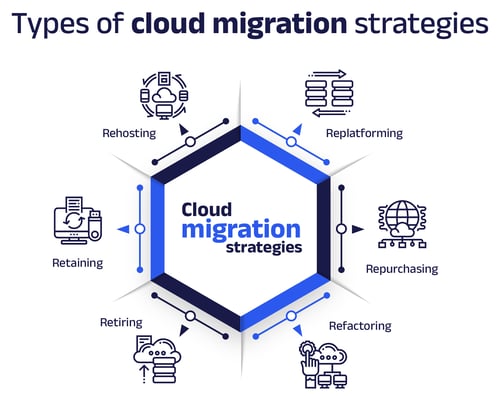What is a cloud migration strategy? Everything you need to know
Nowadays, companies face great troubles by constantly implementing more and more tools to digitize information; we refer to the amount of data which an organization is capable of generating today, both in its internal and external operations; each number, name, address, service, price, and endless data must be placed somewhere, however, it is often scattered in different databases, therefore, there is no safety guaranteed. This makes accessing data difficult and, therefore, obtaining value from it is almost impossible. Time has come to talk about cloud migration strategy.
What is cloud migration?
Before we talk about different cloud migration strategies, you should first understand everything involving cloud migration. This concept refers to the moment in which any business moves partially or completely all of its data, from their storage centers or applications to the cloud. This process is usually carried out through a public cloud service like Amazon Web Services, Google Cloud Platform, Microsoft Azure, among others. There are also private cloud services at hand which could be used.
More and more companies transition information to the cloud as a key point in their organizational digitization plans. Although cloud migration may only be seen as a transition, it must have a strategy that answers questions such as: what cloud strategy should you implement? What service should you hire? What is the best option for your company? How to start? And many more. Our mission at Arkon Data is to be able to give you as many answers as possible, and to guide you through your company’s development.
Cloud migration benefits
The results which plenty of organizations have obtained when making the transition to this new backup and consultation format are positive, here are the most important ones:
- Scalability. In enterprise environments with more traditional systems, Information Technology (IT) areas used to spend on physical servers, software, storage, and network support. Nowadays cloud technology allows working with demanding activities, as well as with a large number of users. A great cloud infrastructure helps manage multiple processes under the same base, without assembling it separately to consecrate the use of technology within a company.
- Costs. When a technological issue is addressed, the magic word “saving” always makes its appearance, without giving the means to achieve it. The fact that an expert IT team allocates time and resources to server maintenance and for updates and error repair, in the medium and long term, represents an economic drain for organizations. Working with data in the cloud facilitates this advantage; whoever provides the service is the one who is in charge of keeping it running so that you can start up your operations and use your efforts in more strategic topics for the improvement of your company.
- Performance. If you are reading this article, it means that you know how the internal performance of your organization can culminate in an excellent customer experience. Taking part of your operation to the cloud helps applications and websites to provide better service to users or end customers by reducing network latency which could exist under more obsolete technological parameters.
- Experience. Those who use cloud services can access it wherever they are; whether they are users or clients, they only require an internet connection. Given the digital dynamism the world is experiencing today, the term "experience" has a weight on any organization described as future or cutting-edge, and connections with the cloud have a direct positive effect for staff members thanks to the ease with which today's software and platforms can be handled.
These 4 powerful terms can make the difference between looking at the future or leaving a process stuck indefinitely.
Challenges of cloud migration
When a company begins a cloud migration process, many challenges appear and expect to be overcomed. Here we mention possible scenarios which happen more often during the implementation of a cloud migration.
- Omission of indicators: cloud migration certainly has benefits, but if a company does not have well-defined indicators or KPI's, it is difficult to know if the change resulted in savings or if cost planning is on the right track. It must be taken into account that both the company's services or applications and the cloud itself change constantly according to business needs.
- Cloud blocking: As your project gains new goals to meet, you may like to expand the use of cloud services. What could be the solution? Maybe extend the service to other platforms. However, one of the drawbacks is when a service provider limits the connection to other clouds; in view of this, it is better to take this into consideration, since a migration process requires time and a considerable workload.
- Data security: almost all cloud service providers have a sufficiently robust security infrastructure, but it is the organization’s responsibility to have sufficient protection measures to guarantee control over data and information loads.
- Lack of strategy: starting the cloud migration without a backup can end in an irreparable error. Backing up from start to finish could be the differentiator of the process’ success. Each set of data needs a specific treatment and it is the organization's responsibility to know it before triggering a migration.
We already talked about migrating to the cloud, but this, as was said before, requires the implementation of a strategy. Now it is time to answer that question.
What is a cloud migration strategy?
If we look at it like a pyramid, the strategy is the foundation of the cloud migration process. This plan must prioritize the workloads, determine migration plans, develop a pilot, generate tests and correct the results obtained. Creating a strategy document should serve as a guide for all teams and members involved, and thus facilitate corrections on the go.
There are situations where source platforms (physical servers or cloud) and destinations have a similar architecture, this facilitates migration processes to the cloud to fulfill its purpose, which has a positive impact since it is adjusted to the cost anticipated in the migration. In addition, it is worth mentioning that if there is a final goal or desired objective, it can be measured when, at the end of the migration, neither the origin structure nor the final cloud infrastructure had the need to interrupt the organization’s daily operations.
Types of data migration strategy
Employing a cloud migration strategy helps you migrate from the main source to cloud quickly, seamlessly, and at lower cost. It’s also possible to determine if workload applications should be replaced, discontinued, rewritten or if it’s possible to transfer them; another point that gets determined in the strategy is if the cloud destiny is adequate for the information or if there needs to be a better option.
Because of their differences, companies need a cloud migration strategy adapted to their needs and objectives to get the expected results. What strategy does your business need? Let’s take a look at some options.
- Rehosting: better known as lift and shift, it consists of transporting a faithful copy of the current structure to the cloud. This is a great option for small businesses with an ever growing but controlled data volume.
- Replatforming: the main app architecture stays the same; however, there’s a variation with rehosting, as there have to be some adjustments to optimize cloud migration. This is a great option for entrepreneurs who wish to build a step-by-step path to the cloud.
- Repurchasing: updating it can be very expensive and almost impossible if it's in an obsolete architecture before being migrated. This strategy is the perfect solution if current systems are already obsolete. The importance here is to start a new solution according to the information captured; it is necessary to train users and staff members who will have contact with it.
- Refactoring: this type of strategy consists of rebuilding your data architecture from scratch. An ideal cloud migration strategy for businesses that wish to take that leap and leave on-premises configurations behind.
- Retiring: when migrating, there’s a chance of obsolete modules to appear which can represent not only an expense, but also a security problem. At this point, it is best to remove them and not migrate them to the cloud due to the risk of keeping them.
- Retaining: Unlike the fifth strategy, there are possibilities to maintain modules locally. The reasons may be the lack of compatibility with the cloud or any financial issue. Faced with a situation like this, the ideal is to manage a hybrid scheme of strategies and meet company’s needs.

Types of cloud migration.
Before implementing any of the cloud migration strategies, you must check some aspects beforehand and take the path that best suits your project.
- Security: taking care of information in the cloud is a responsibility shared by a part of the organization and to whoever offers the service. You must not lower your guard to avoid any vulnerability in your data.
- Governance and compliance: in terms of regulations, most clouds provide services with an advanced degree of legal compliance, however, it is up to companies to adjust to these regulations depending on the place or country where the information is stored.
- Cost management: a lack of control in data management can cause unforeseen expenses, so it is necessary to keep great control of information so that it gets used and not replicated.
Conclusion
You've reached the end of this article and it's time to recap the highlights of a cloud migration strategy. Here's what your company should consider when deciding on cloud migration:
- Plan a solid strategy that serves as a guide for each step to follow and indicates what to do in case of failures.
- Cloud migration can be total or partial, depending on the needs of the company.
- Cloud migration is a solution for both growing and consolidated companies.
- An effective cloud use can help make the most out of economic resources if its capabilities are exploited 100%.
- Building a strategy covers key points like developing a pilot and fixing bugs
- Knowing all types of strategy will help you decide which one you need, or use more than one to consolidate your project.




